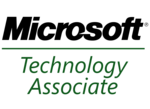Exam 98-362: Windows Development Fundamentals/Creating Windows Forms Applications
This lesson covers Creating Windows Forms Applications. It looks at events, Windows Forms inheritance, controls, user input, and debugging.
Activity 1 - Create and Handle Events
[edit | edit source]This objective may include but is not limited to: methods for creating events in an application; handling events raised in an application.
- Read Creating a User Interface.
- Read Events Overview.
- Read How to: Create Event Handlers at Run Time for Windows Forms.
- Read How to programmatically add controls to Windows forms at run time by using Visual C#.
- Read How to programmatically add controls to Windows Forms at run time by using Visual Basic.
Activity 2 - Understand Windows Forms Inheritance
[edit | edit source]This objective may include but is not limited to: implementing forms inheritance in applications for visual inheritance.
Activity 3 - Understand How to Create New Controls and Extend Existing Controls
[edit | edit source]This objective may include but is not limited to: creating a new GUI control or inheriting functionality from an existing control.
- Read Varieties of Custom Controls.
- Read Control Type Recommendations.
- Read Walkthrough: Inheriting from a Windows Forms Control with Visual C#.
- Read Walkthrough: Inheriting from a Windows Forms Control with Visual Basic.
Activity 4 - Validate and Implement User Input
[edit | edit source]This objective may include but is not limited to: implementing the correct user input model based on application design and requirements; accepting keyboard and mouse input; validating user input through GUI controls such as text boxes and dialog controls.
- Read User Input in Windows Forms.
- Read Using Keyboard Events.
- Read Mouse Input in a Windows Forms Application.
- Read User Input Validation in Windows Forms.
- Read MaskedTextBox Class.
- Read Control.Validating Event.
Activity 5 - Debug a Windows-based Application
[edit | edit source]This objective may include but is not limited to: using breakpoints and debugging techniques to identify issues in code; debugging a Windows Services application.
- Read Debugging Managed Code.
- Read Walkthrough: Debugging a Windows Form.
- Read Debugging Windows Service Applications.
- Read How to: Debug Windows Service Applications.
- Read How to: Debug the OnStart Method.

